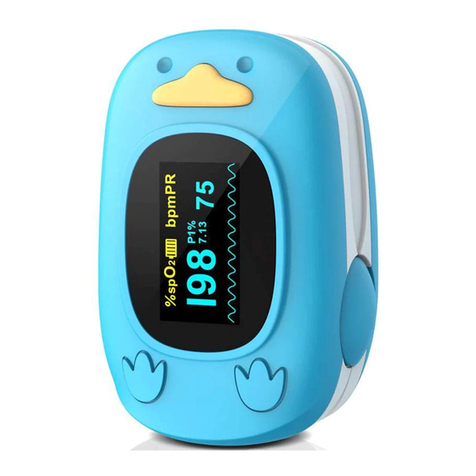
NEULOG PULSE SENSOR GUIDE
Note: Make sure not to download and install both types of software they
will conflict on the computer.
Procedure:
1. Install the NeuLog software.
2. Connect the USB-200 module to the PC or Mac.
3. Connect the heart rate and pulse sensor to the USB-200 module (they
directly plug together). Please note no calibration is required for this
sensor.
4. Open the NeuLog software.
5. Once a heart rate and pulse sensor logo appears on the left side of the
screen the probe has been automatically identified and you can begin
experimentation.
6. If the heart rate and pulse sensor is not automatically identified, click
the “Search for sensors” icon to find the sensor.
7. Click the “On-line experiment” button; this will open a graph below.
8. Click on the “Module setup” button located on the heart rate and pulse
sensor icon in the module window to change the sensor's settings if
need be.
9. Click on the "experiment set up" button to change the experiment
settings if need be (experiment duration for example).
10. The heart rate and pulse sensor will give a live reading in the box to
the left of the screen while plugged in.
11. To run an experiment and collect data click “Run experiment”.
12. To end data collection early, click “Stop experiment”.
Tablet, smart phone device
Materials needed:
NUL-208 Heart Rate and Pulse sensor
WIFI-201 WiFi Module
BAT-200 Battery Module
Your heart rate and pulse sensor needs to be connected to a WIFI-201
module. The WIFI-201 module will create a closed NeuLog WiFi network
which will stream the NeuLog data to the device of your choosing. Once
your device is wirelessly connected to the NeuLog network you can run
experiments and collect data through a browser of your choosing.
Procedure:
1. Connect the heart rate and pulse sensor directly to the left side of a
WIFI-201 module (no wires required).
2. Connect a BAT-200 module to the right side of the WIFI-201 module.
3. Although not required, we recommend plugging the BAT-200 to an
outlet using a USB to mini USB charger (such as a typical cell phone
charger). The WIFI-201 module will run for 15-75 minutes (depending
on the sensor) without being plugged in.
4. The WIFI-201 can be powered directly using a mini to USB cord and
plugging it into your computer or a wall charger. Please note this
function is only available on WIFI-201 units with the USB icon on the
cover.
5. For further WIFI-201 instructions or the WIFI-201 quick start guide
please visit:
www.neulog.com/Download/SoftwareandApplication.aspx
6. The WIFI-201 indicator lights will flash; take no action until the LED
to the far left turns blue; this can take up to one minute.
7. Take your tablet or smart phone, go to the WiFi settings and select the
Neulog network which matches the WIFI-201 Module ID found on the
back of the WIFI-201 device. (NeuLogXXXX for example).
8. Give your device about 20 seconds to connect to the WIFI-201.
9. Once the device is connected, go to your browser and type the website
wifi201.com into the URL bar, then wait for 30-60 seconds.
10. You will see a “Control mode” icon in the browser, click on this icon.
11. The browser will then load a new screen and begin to auto detect the
sensor(s); this can take a minute. (You can stop the search when the
sensor is found.)






















